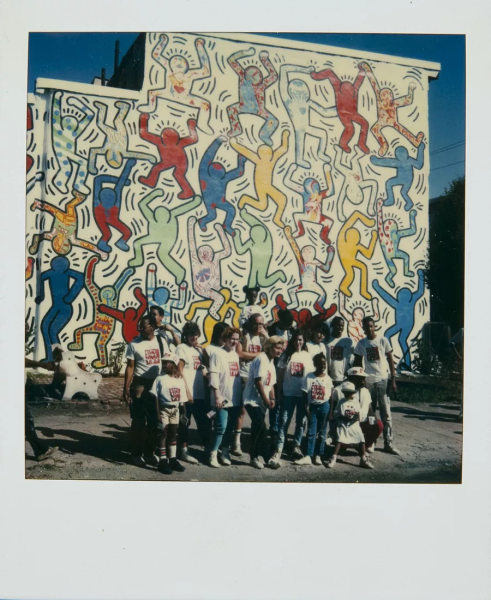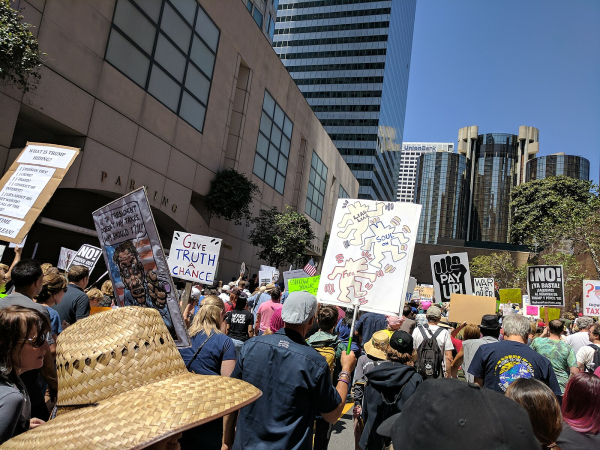In the dynamic array of contemporary artists, few have left such a profound and impactful mark as Keith Haring (1958-1990). A revolutionary artist, social activist, and a beacon of the vibrant New York City art scene in the 1980s, Haring has left a legacy that goes beyond the canvas. He democratized his art and used it to convey very important social issues and to advocate for reforms. He has stood as a monumental, inspirational person whose legacy still lives on to this day.
Emerging as a street artist in the early 1980s, Keith Haring developed a signature style, characterized by bold lines, vivid colors, and instantly recognizable figures, that became synonymous with the energetic spirit of the times. From the chalk and graffiti public art that he first started with, he quickly rose to fame. Now he continues to stand as a universal symbol of peace as his artwork can be found on numerous pieces of clothing, both for the youth and for the old that remember the age of his uprising.
Upon hearing the name ‘Keith Haring,’ many people will quickly recognize his name and his work. Even if someone is unaware of his name, they most likely have seen his art. Haring holds a very distinct art style that can be easily distinguishable. Whether it is reproduced on clothing, viewed in famous museums, or even seen online, Haring’s art is ubiquitous. The spread of his activism and expression is fervent all throughout the media, and all over the world.
To the blind eye, if one were to quickly glance at his pieces, many would think that they are simply figures with bold colors. However, the more you look into his work, the more you are able to see how he truly used art to express ideas of protest and to fight for what he believed in.
Beginnings
Keith Haring was born on May 4th, 1958, in Reading, Pennsylvania. As a young boy, he started his love for art through cartooning skills taught by his father, who was an amateur artist. Later in his life, he continued to discover different versions of art that he could further pursue. In 1978, he moved to New York City and enrolled in the School of Visual Arts (SVA).
His enrollment in SVA was a huge contribution to his further involvement in the artistic world. He befriended many types of artists like him, but he also made friends with musicians, graffiti artists, and performance artists. In SVA, he worked with multiple different mediums and experimented with his developing style. His increased interest in public arts was heavily influenced by Jenny Holzer, William Burroughs, Pierre Alechinsky, and Christo.
Chalk and graffiti were the very notable art mediums that he fixated on at the start of his art career and education. Throughout his era of chalk work, he began to truly discover the artistic expression that he would want to later pursue. “All kinds of people would stop and look at the huge drawing and many were eager to comment on their feelings toward it,” Haring wrote. “This was the first time I realized how many people could enjoy art if they were given the chance. These were not the people I saw in the museums or in the galleries, but a cross-section of humanity that cut across all boundaries.” As an artist, his efforts were to make his art accessible to the public. One would have been able to find his work all over the subways and streets of New York City.
Graffiti in New York City
During the early 1970s, the Bronx was facing economic decline, social unrest, and neglect from city authorities. Young people in this environment, often from lower-income neighborhoods, found an unconventional outlet for their artistic expression through graffiti. Subway trains became their canvases, and spray paint became their medium. This rebellious form of self-expression allowed individuals to reclaim their surroundings and make a bold statement in a city that seemed to have forgotten them. The rise of graffiti in New York City can be attributed to major key factors. Hip-hop culture, which emerged during the same period, played a significant role in promoting graffiti as an essential element of self-expression.
The initial response to graffiti was hostile, with law enforcement suppressing “vandalism.” However, as graffiti art began to gain more traction in the mainstream art world, more attention was being drawn to the pure creativity and expression in these modern artworks. Later on, many different galleries began to showcase graffiti as a legitimate form of art.
By the 1980s, graffiti became a global phenomenon. The international art world recognized the unique visual and cultural significance embedded in the bright and inspirational pieces. Graffiti was able to transition from the streets to gallery walls, bridging the gap between the underground and mainstream art worlds.
Graffiti was one of the ways Haring was able to truly discover the impression he wanted to leave on the art community. He wanted to rewrite the rules of art and to show all the possibilities that can be achieved when “coloring outside of the lines.”

Haring’s Purpose
The factor that draws people to Haring’s art and unique style is due to the fact that his art truly emits meaning and intention. He creates works of art for all so that everyone is able to access it and cherish it. His art is available for all different groups of people. The true importance that Haring is able to convey through all his pieces is his true passion and life through his works. The true charm that is able to be shown through his art is that he did not care about popular opinion of what contemporary art “should” or “should not” be. He paved the way to bring art and diverse communities together. During his studies at SVA, he wrote, “The public has a right to art. The public is being ignored by most contemporary artists, art is for everybody.”
He has also stated that he believed art was not centered around the rich and wealthy. He broke the bounds of how art was defined in the 1980s, stating that his art was for, “real people, people who don’t have any art background…but who respond with complete honesty from deep down inside their hearts or their souls.”
Another contributing factor to his popularity could be the simplicity that his art holds. The attraction that his art holds to be able to convey such raw and real issues of the world was able to resonate with viewers.

Symbolism
As mentioned before in the previous sections, the two most famous symbols that Haring commonly used were the “Radiant Child” and the “Barking Dog.” One may ask, why this seemingly random choice for icons? However, reading more about his different works and the thought process behind them, it is clear that Haring does everything with purpose and intent.
Radiant Child/Baby:
The baby is known to be one of the most recognizable symbols that Keith Haring has implemented throughout his works. It is an outline of a baby or child on its hands and knees with emanating lines surrounding them. The meaning of this symbol, as said by Haring, is to represent goodness, purity, and youthful innocence. Haring famously said, “For me, children represent the future, the image of perfection. There is nothing negative about a newborn baby, nothing.” The radiance and glow that is shown by Haring depict the life and potential that the child holds. The child is able to represent capability, independence, and promise. A symbol of hope, determination, and perseverance. Relating back to his art, the baby could represent the rebirth and revitalization of the art.

Barking Dog:
Similarly to the baby, a barking dog is also featured in a large portion of Haring’s work. Haring’s signature style of the dog allows it to also be recognizable. He created the image in 1986. During this time, the United States was experiencing significant social and political turmoil. There can be many different interpretations attributed to the symbol.

It can fundamentally be seen as a symbol of activism, resistance to oppression, and confrontation. The lines that are emitted from the dog indicate the sound of loud barking, as these lines are radiated from its mouth. It can symbolically and physically show the need for more direct and outspoken activism. Haring himself was involved in many verses of activism for a multitude of issues. He mainly was known for his work on AIDS awareness, fighting against the apartheid in South Africa, and anti-nuclear work. He was incredibly vocal on these topics, and the more he spoke about them, and the more he created art, it naturally followed that more of these dogs would appear.
Another point that can be said is that the dog symbolizes Keith Haring himself. It is possible that this dog speaks about his advocacy on these topics, and how Haring is unapologetically himself. The dog is vocal and determined. In a way, it’s able to represent the motive that continued to fuel Haring during both his artistic and personal life.

Artworks and Activism
Haring always continued with his ideology to spread the ability of his work to all, and he was incredibly successful in doing so. Through his foundation’s website, one can easily access images of many of the murals that he has painted in his lifetime. Haring did not only paint in well-known open areas, but he also would make murals on random streets, inside apartment walls, colleges, community centers, and even at schools and hospitals.
By 1982, he began to travel and produce and provide art to all corners of the world. A few mentionable murals that were considered his most famous and well-known murals were, “Crack is Wack,” “We the Youth,” “Free South Africa,” and the Berlin Wall. With these murals, it is clear to see how his art and his morals were intertwined. Through these murals and paintings that were spread all over, he was able to consistently spread his activism. He didn’t create art just to “make” art, but instead, he curated his artwork to speak to the souls of the people who viewed it. His imagery has even been referred to as “visual language.”

In 1987, Keith Haring was diagnosed with AIDS, and he shortly passed away in 1990 at only 31 years old. A year before this, he created his final work of art, Unfinished Painting. Although the painting is seemingly cut short, and incomplete, this choice was an intentional lasting message from Haring, as a commentary on the AIDS crisis. It not only was meant to speak for himself and his own experience but also to speak for others who could not. During the 1980s, his activism and educational awareness was especially crucial. According to the CDC, from 1981 to 1990, 100,777 people died due to AIDS. In a 1989 interview with Rolling Stone Magazine, Haring said, “AIDS has made it even harder for people to accept because homosexuality has been made to be synonymous with death. It’s a justifiable fright with people who are just totally uninformed and therefore ignorant. Now it means that you’re a potential harborer of death. That’s why it is so important for people to know what AIDS is and what it isn’t.” This painting has such a powerful meaning behind it, and even through such a difficult time for him, he continued to be vocal in his advocacy.

Keith Haring took the art world by storm, with his work spreading like wildfire. So the next time you see a piece of Haring’s art, you will understand the power that his symbolism has held for people everywhere. The key to its power is with its seeming simplicity. As Leonardo da Vinci once said, simplicity can be the ultimate sophistication. And as Haring himself wrote in his journal, “My decision to come to New York and become a ‘public’ artist was spurred by my desire to communicate and contribute to culture and eventually history.”
“This was the first time I realized how many people could enjoy art if they were given the chance. These were not the people I saw in the museums or in the galleries, but a cross-section of humanity that cut across all boundaries,” wrote Keith Haring.

